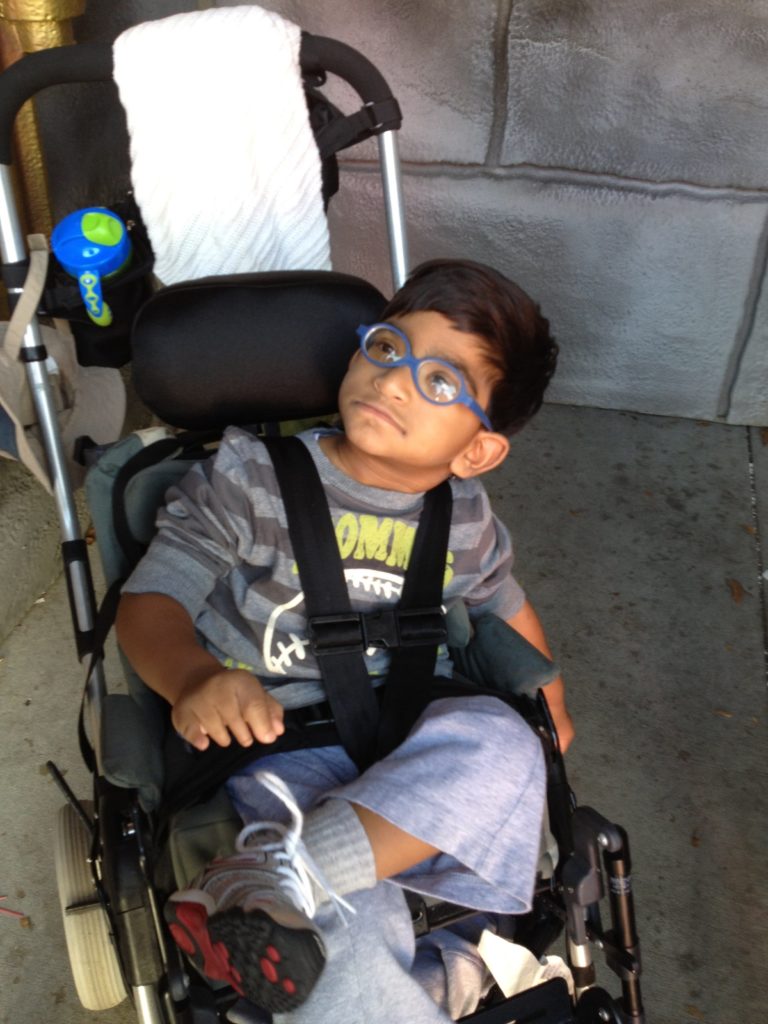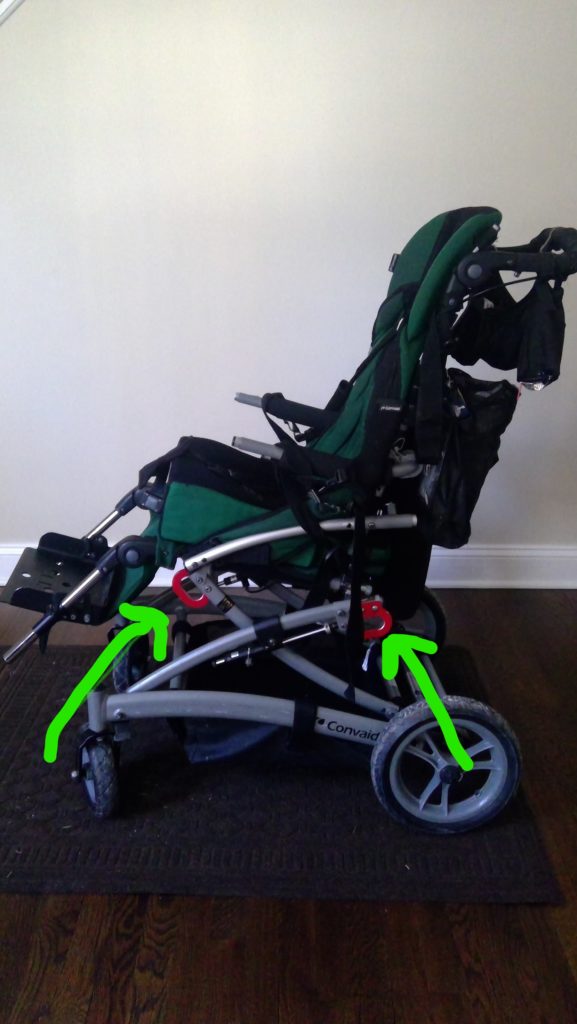Wheelchair for Your Young Child – How do you choose the right one?
If your young child is unable to walk yet or has a permanent disability you may be using a baby/toddler stroller to get them around. Our son had poor trunk control and was unable to sit up on his own until the age of three. I was always looking at the latest strollers wondering if it would have just a little more support than our current one. I thought, “If it did, we may not ultimately have to get a wheelchair”.
We ended up going through a variety of strollers. Eventually, our son became to tall to comfortably sit in any of them and we came to terms with the the fact that he needed a wheelchair. So, appointment #29 was made for the equipment clinic at the local childrens’ hospital.
Equipment Clinics
The advantage of most equipment clinics are that there is a physical or occupational therapist on staff along with a representative from an equipment company (who does the actual ordering of the wheelchair) in the same place. They can work together to find the best options for your child and start the process to order what you need. Many equipment clinics also have sample equipment in the clinic that your child can try, which is definitely a bonus . No parent wants to battle insurance for months, then wait for the wheelchair delivery for months, only to end up feeling like you made the wrong choice. This is where equipment clinic is worth the extra appointment.

So what should you be thinking about when seeing all of the options?
I want to give you some things to consider so you end up choosing not only the right wheelchair for your child but also a wheelchair that fits your lifestyle and will get used rather than becoming a coat rack. The following are worth considering:
- What supports are needed? The type of support your child needs will dictate your options. For younger children, there are more stroller-like options that can also give additional supports such as head support, trunk support, and leg straps.
- What is the primary use for this chair? Will you only be using it when you leave the house or will you be using it within the home as well? What are the most common places you will go with the chair? Do you need the chair to turn tight corners in a restaurant? Will the size of the wheelchair base allow you to do this? Can you push it easily in those places?
- Will your child ever ride the school bus with this chair? If so, you will need to be sure the chair has an option for bus attachments (see pic below). This does not automatically come with the chair in most cases and must be specified at the time of ordering. It is always a time-consuming ordeal to order parts for wheelchairs later on so this is definitely something to think about at the time of ordering.
- Do you need the wheelchair to fold? For me, this was the most important factor. This is where it is helpful if you can see an actual wheelchair so you can try to fold it yourself and LIFT it. I went to the equipment clinic twice before deciding on our son’s first wheelchair/stroller combo because I wanted to make sure I could fold it and lift it into our SUV!! The type of car you have will be a factor in this decision too because you have to lift it into the car and fit it in. If you think folding and lifting it is difficult while testing it out, this chair may just end up in your garage while you continue to use the stroller for your child. Obviously, there will be trade-offs as lighter options may not come with as many features for your child but it’s really about what is going to be right for you and your child. Is the wheelchair with the most features so great if it never gets used compared to the lighter option that has a decent amount of features but not ALL of the features? Be comfortable with your selection and good luck!

Additional wheelchair options
There are many other options for wheelchairs that the therapist and equipment vendor will evaluate with you. Some of these include an attachable tray, oxygen holder, canopy (with strollers), etc. If you think there is a chance you may need it, go ahead and order it with the wheelchair.
It is much more difficult to order and have insurance approve these options later.
Your insurance may or may not cover all of the options you request. These items must be deemed medically necessary in their eyes, but the equipment clinic staff can help guide you through this process.
Our experience with wheelchairs
The KidKart
Overall we were pleased with the two stroller/wheelchairs above. The KidKart is likely outdated by now so I won’t comment on it too much. It was nice for navigating through tight spaces such as the mall or a restaurant. The was a tilt feature which we used when our son fell asleep or had a seizure. The seat portion lifts off the base and will fold easily, making it less cumbersome getting it into our SUV). The one thing I was not impressed with was the tray (it kept falling off).
The Convaid Rodeo
The Convaid Rodeo https://www.convaid.com/rodeo/ is the wheelchair/stroller we are currently using and have been for the past 4 years. We chose this model over other more compact Convaid models ( Convaid EZ Rider and Convaid Vivo) because it has both a recline and a tilt-in-space feature.
What is the difference between recline and tilt-in-space? Recline means the back reclines independently from the seat, like in a baby stroller. Tilt-in-space means that the seat and back tilt, keeping your child’s torso and thighs at a 90-degree angle. This is recommended to avoid having the hips slide in the seat, thus disrupting the position. Tilting-in-space is generally recommended over reclining, especially for children who need a considerable amount of support. This is because it avoids unnecessary stress to the body by keeping the hips aligned.
The Rodeo’s options include a canopy, oxygen holder, and under stroller basket. We went for the Rodeo so that if our son fell asleep on outings he would be comfortable. This chair does not separate as the KidKart did.
If your child does not need much support, is somewhat mobile, and you will be in and out of the car a lot, you may want to look at some of Convaid’s other models. Our son does not walk at all, so we felt that his comfort was more of a priority.
The Quickie Iris Wheelchair
We finally got our Quickie Iris after months of going back and forth with the insurance company and the DME company. I’m exhausted just thinking about the number of phone calls I made for this chair. On our way to pick it up, I thought, “If this chair is anything less than perfect I might cry”.
It turns out the Quickie Iris is pretty great. It definitely looks like a real wheelchair as opposed to the Convaid Rodeo which looked more like a stroller. Perhaps this is also because the Iris is in the next size up so everything just looks more overwhelming.
The primary reason we chose the Iris over the Rodeo was because it’s frame is compatible with mounting our son’s communication device. Our son uses an eye gaze device for communication (Tobii Dynavox). The device cannot be mounted in a stroller-like chair (i.e Rodeo) because the mount is not compatible with the frame. But, honestly, I think it was the better choice.
It’s great to pull up to the table. In comparison, the Rodeo sat a little higher and was a difficult to roll up to certain tables. The Iris is easier to use indoors and in tighter spaces.
It is also useful if your child is learning to perform a stand-pivot transfer. This is because the footrests swing out of the way to allow your child to stand from the chair. The Rodeo did not allow that because the footrest was one solid peice as pictured above. The Iris tilts easily and easily rolls right up to the table.
The downside? It’s not great on uneven terrain, even grass! There also isn’t a canopy like with a stroller-like wheelchair such as the Rodeo or EZ Rider. I am not sure if you can purchase different wheels to make it easier to use outdoors. It might be worth asking about.
In terms of accessories, we ordered the oxygen holder. I thought it was ordered with the wheelchair but IT WAS NOT ORDERED! So there went another 6 months of waiting. I really dropped the ball on that one! MY ADVICE IS TO CONFIRM ALL ACCESSORIES and OPTIONS BEFORE LEAVING THE EQUIPMENT CLINIC.
We also needed a suction storage space but the IRIS does not have one from the manufacturer. Our DME provider had to have one made for us by another vendor, but fortunately insurance still covered the cost.
In the end, it was worth waiting for the Iris.
Our son seems very comfortable in it, it’s easy to maneuver, and has many features. Stay tuned for a video soon!
Most insurances will pay for only one wheelchair every 3-5 years, so choosing a wheelchair is definitely a big decision. I hope you now have the right tools to tackle this head-on! Good luck and feel free to send comments or questions.
